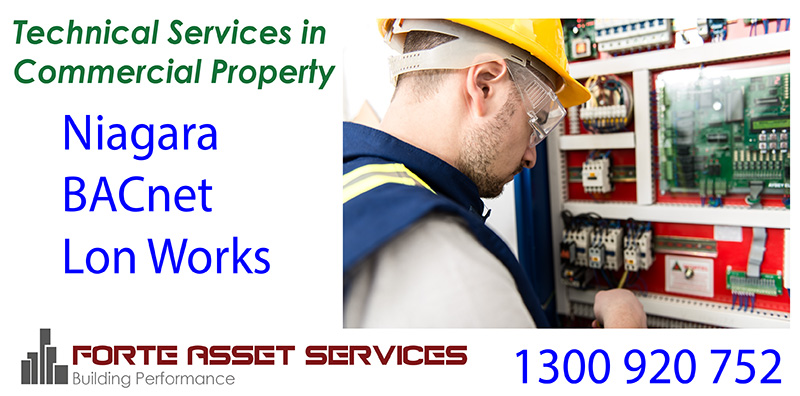
Building Technology Sustainability
Building Technology Sustainability: The opportunities to implement Technology in Facilities can often be discovered and improved at low cost and achieve sustainable outcomes for energy conservation which benefit the building’s performance in both financial terms, esthetics and indoor environmental conditions. In real terms, in our physical daily work in commercial buildings, what exactly does this mean for property and facility managers?
Technologies:
Every Facility has a level of technology already in use, be that low level control, based upon human intervention, or a higher level of control with a totally integrated Building Management System that has all the current Protocols, or something in between.
Our Clients are interested in maximizing their opportunity to improve for the best possible outcomes, be that with their existing technology or new technology. The point is, to gain the most efficient value for money from the data the technology can deliver. We can offer sustainability Strategies with existing technology or new, it depends upon what you have installed now and where you want to be. call or e-mail us to discuss this further.
Sustainability and Technology:
Building Technology Sustainability Performance is measured by NABERS in a comparison against the Facility’s Peers. The improvements developed and integrated into the facility to continually assist to improve this rating can also be measured against historic performance data of the site. Key indicators,  targeted from your strategic plan, can be established and the data verified to ensure forward movement to improved ratings. Integrating the correct technology to key points for logging and reporting assist greatly to delver the data needed for this verification, and consequently, ensure correct stewardship to the goal of improved rating and Return on Investment. Remember, NABERS is an annual assessment.
targeted from your strategic plan, can be established and the data verified to ensure forward movement to improved ratings. Integrating the correct technology to key points for logging and reporting assist greatly to delver the data needed for this verification, and consequently, ensure correct stewardship to the goal of improved rating and Return on Investment. Remember, NABERS is an annual assessment.
Tell your People:
The same technologies used to implement Sustainability Improvement can also be used to tell your people, “celebrate” the achievements. This also has the added benefit of creating culture change; its advertising, promoting your facility and it continued benefits to your people. Web sites, Video Displays, graphics representation, live data streaming and so forth. This sounds expensive, but it is simply an extension of the technology, not an additional system.
The Live Display provides streaming data in real time which occupants can see actual change in Energy Consumption. Automated Screen dumps or reports e-mailed to management each Work day morning telling them of the Energy consumed last week or yesterday, up dating consumption goals and out comes..
Strategic opportunities include:
- Reduce Operational Costs
- Develop a plan
- Culture change
- Involve all parties
- Monitor and measure
- Celebrate, tell your people
- legislation compliant
- Waste Management
- Recycle
- Leadership
- integrity
Cost
Any decent Facility Manager or property manager whom has read this article would be questioning the cost. Simple control changes in major plant equipment can cost a small fortune, how long will it take for the returns to crystallize for our landlords or investors? Is it a quick alteration by a trades person or is it a major undertaking requiring all the expense and diligence of any major capital expenditure project.
Ask the questions of the right people
Let me put this to you, you have a lot of the answers already, via the technicians, the building manager and the tradespeople whom regular visit your sites.
Ask them a few questions and ask for suggestions to make improvements with the technologies they may be using on other sites or commissioning on major projects. Some suggestions could be as little as a days labor and could have significant benefits. you won’t know until you ask and visit the issue or opportunity yourself, to understand whats involved.




[…] should a Landlord Upgrade building management system technology in their commercial […]
[…] are passionate about the opportunities technology can deliver for our clients and their Facility Building Operations. Call us and engage our […]
[…] consumption data delivers the foundations for effective change which enhances your sites overall sustainable carbon foot print. The more observations you can automate, via the data, the easier it is to […]
[…] equipment, as a generalization, does not have current technology and is typically a high energy consumer, a symptom of sick building […]
[…] are passionate about the opportunities technology can deliver for our clients and their Facility Building Operations. Call us and engage our […]
Mastering the Art of Commercial Property Negotiation: Strategies for Success
Commercial property negotiation is a delicate dance that requires finesse, strategy, and a deep understanding of the intricacies involved. From securing favorable lease terms to closing a sale, effective negotiation plays a pivotal role in determining the success of any commercial real estate transaction for instance property in Noida. In this comprehensive guide, we delve into the world of commercial property negotiation, exploring its significance, key techniques, essential considerations, and the art of striking deals that benefit all parties involved. Whether you’re a property buyer, seller, tenant, or investor, this article equips you with insights to navigate the intricate landscape of commercial property negotiation.
The Significance of Commercial Property Negotiation:
Commercial property negotiation goes beyond price haggling; it’s a dynamic process that shapes the terms, conditions, and outcomes of a transaction:
Optimal Outcomes: Effective negotiation leads to win-win solutions, fostering positive relationships and ensuring mutual satisfaction.
Risk Mitigation: Negotiation helps clarify expectations, mitigate potential disputes, and minimize legal and financial risks.
Value Maximization: Strategic negotiation can lead to favorable terms, enhancing the overall value of the transaction.
Key Techniques for Successful Commercial Property Negotiation:
Thorough Preparation: Research and gather information about the property, market trends, and the other party’s motivations.
Clear Communication: Establish open and transparent communication to foster trust and ensure both parties are on the same page.
Active Listening: Pay close attention to the other party’s needs and concerns to identify areas of compromise and mutual benefit.
Creative Problem-Solving: Explore alternative solutions and flexible approaches to reach agreements that address both parties’ interests.
Essential Considerations in Commercial Property Negotiation:
Price and Terms: Negotiate the purchase or lease price, along with other terms such as rent escalation, lease duration, and payment schedules.
Property Condition: Discuss property condition, repairs, maintenance responsibilities, and any necessary upgrades or renovations.
Legal and Regulatory Compliance: Ensure that the transaction adheres to zoning regulations, permits, and legal requirements.
Due Diligence: Allow time for due diligence, including property inspections, financial reviews, and title searches.
The Art of Balancing Interests:
Buyer-Seller Negotiation: Buyers seek favorable prices and terms, while sellers aim to maximize profit. Effective negotiation balances these interests.
Tenant-Landlord Negotiation: Tenants aim for affordable rent and favorable lease terms, while landlords seek fair compensation and reliable tenants.
Win-Win Solutions: Strive for mutually beneficial outcomes that create value for both parties, fostering long-term relationships.
Challenges and Considerations in Commercial Property Negotiation:
Emotional Dynamics: Emotions can influence negotiations. Maintain professionalism and objectivity to achieve the best outcomes.
Power Imbalance: Parties with greater leverage may have the upper hand. Skilled negotiation can help level the playing field.
Cultural Sensitivity: Be aware of cultural differences that may impact negotiation styles, customs, and communication.
Leveraging Technology in Commercial Property Negotiation:
Virtual Tours: Use virtual reality and 3D tours to showcase properties remotely, saving time and resources.
Digital Document Management: Streamline the negotiation process with secure, digital document sharing and e-signatures.
Conclusion:
Commercial property negotiation is an artful blend of strategy, communication, and compromise that shapes the course of real estate transactions. By understanding the significance of negotiation, mastering key techniques, considering essential factors, and embracing the art of balancing interests, buyers, sellers, tenants, and investors can navigate the complex landscape of commercial property negotiation with confidence and finesse. Whether you’re securing favorable lease terms, closing a sale, or building lasting business relationships, the realm of commercial property negotiation invites you to engage in a dynamic process that unlocks opportunities, fosters collaboration, and propels you toward successful real estate ventures.